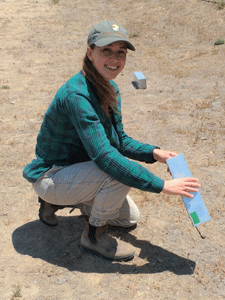Assessing wildlife use of agricultural ditches
Summary:
Vegetated agricultural ditches provide environmental benefits, such as filtration and removal of sediment, nutrients, and pesticides from water, but they may also encourage the presence of wildlife near and/or in crops, posing potential food safety risks. Lack of information about food safety risks posed by wildlife communities in agricultural ditches impedes implementation of a practice proven to improve water quality. This study will address this gap in knowledge by comparing rodent and amphibian communities among agricultural ditches having bare ground, managed vegetation, and unmanaged vegetation.
Investigator:
Jennifer Duggan
Assistant Professor, Department of Applied Environmental Science
California State University, Monterey Bay
Project description:
Vegetated agricultural ditches provide environmental benefits, such as filtration and removal of sediment, nutrients, and pesticides from water, but they may also encourage the presence of wildlife near and/or in crops, posing potential food safety risks. Prevalence and risk factors for shedding of several food-borne pathogens have been assessed in a number of rodent and amphibian species in California, but because little is known about how vegetation influences the composition of rodent and amphibian communities in agricultural ditches, estimates of actual food safety risks remain uncertain.
In the face of such uncertainty, some buyers require bare-ground buffers around berry and vegetable crops in California, which growers provide by taking costly land out of production and/or maintaining bare ditches. As a result, the adoption rate of vegetated ditches remains low. Thus, lack of information about food safety risks posed by wildlife communities in agricultural ditches impedes implementation of a practice proven to improve water quality.
This study will address this gap in knowledge by comparing rodent and amphibian communities among agricultural ditches having bare ground, managed vegetation, and unmanaged vegetation in the Salinas Valley of California. For one year, I will use seasonal mark and recapture surveys to collect information on species richness and relative abundance of rodents and amphibians located in agricultural ditches adjacent to vegetable and berry crops, as well as information on the length of time spent by uniquely marked individuals inhabiting agricultural ditches. When combined with known pathogen prevalence, this data will improve estimation of food safety risks and guide effective control of rodents and amphibians with strategies tailored to specific cases.
To promote informed decisions for co-management of water quality and food safety, results will be shared across the distribution chain through peer-reviewed publications, brochures, website publications, presentations at grower-targeted meetings, and meetings with distributors and buyers.


